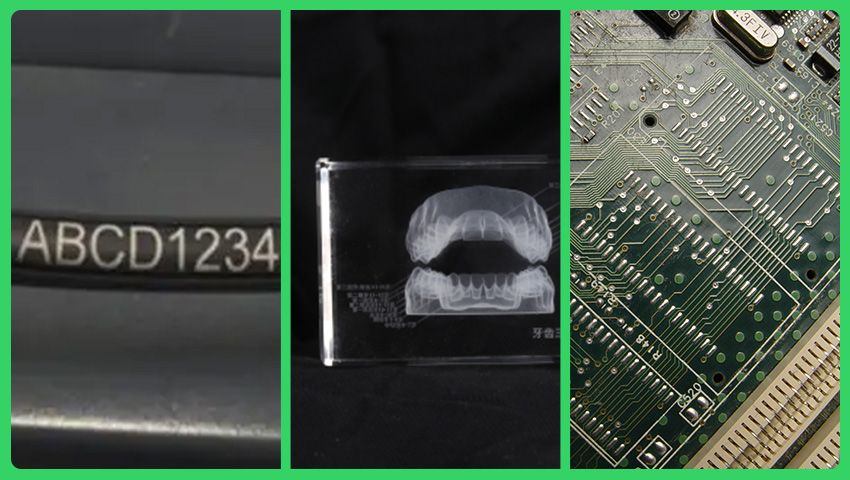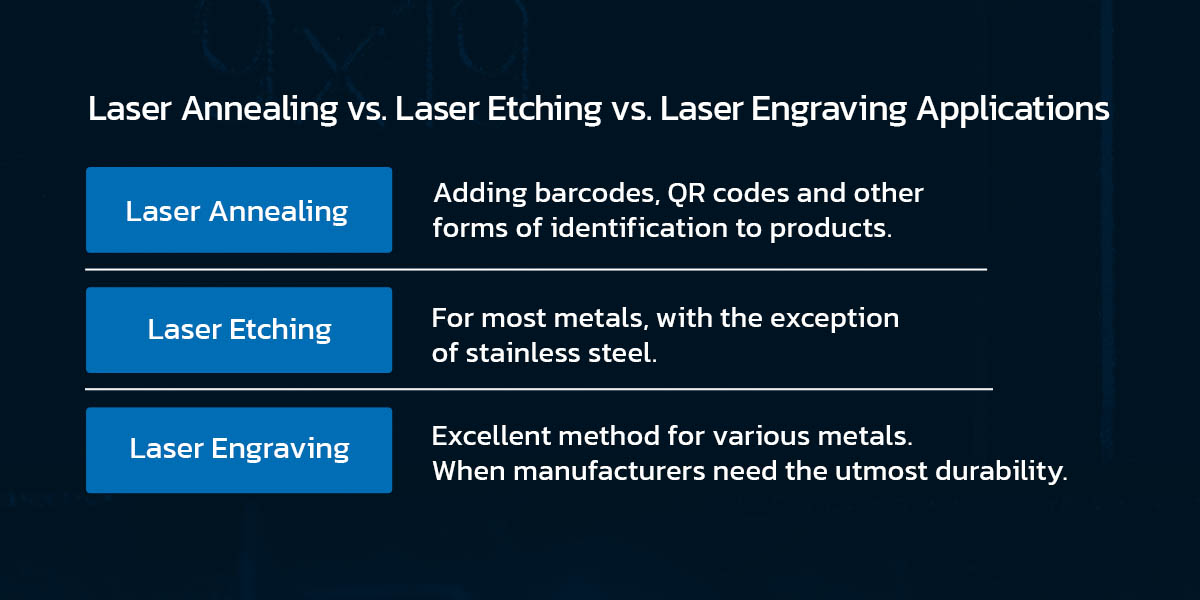
Laser annealing, laser engraving and laser etching are all commonly used terms in manufacturing when a laser creates a legible mark on a substrate. However, these terms are not interchangeable. These three processes achieve different outcomes and also have different effects on the materials they’re used on.
Understanding what separates these laser treatments is valuable for identifying the best process for your goals and choosing the correct laser equipment for your manufacturing floor. Review these methods to find the right laser marking systems and solution for your operation.
Laser annealing is a non-contact laser marking technique used to create permanent colored marks on a substrate. During the process, a de-focused infrared laser is applied to the material, raising carbon to the surface. The laser slowly heats up the material’s internal molecules, causing them to oxidize.
When the metal cools, its crystal lattice reorganizes, resulting in a permanent color and material surface finish change in the desired area. The final color depends on the temperature applied to the metal, though a dark black is the most easily achievable.
Annealing produces the best results on metals containing alloys, such as stainless steel, chrome and titanium. Ferrous metals, such as iron and carbon steel, are also suitable for annealing.
Laser annealing is generally used for applications like adding barcodes, QR codes and other forms of identification to products. Laser annealing is especially useful for products that will be used in highly sterile or corrosive environments, such as medical offices, or for identification purposes. Barcodes, QR codes and part numbers are all typical forms of identification added to products, including but not limited to:
Laser annealing offers many benefits to manufacturers:
The main drawbacks of laser annealing include:
Laser etching melts a substrate’s surface to create a raised mark. The laser beam uses short pulses that allow the substrate surface to absorb just enough energy to melt the micro surface. Unlike engraving and laser annealing, this treatment leaves the surface slightly raised. The color of the etching can be white, black or gray, depending on the ratio of absorption to reflection.
Laser etching can be used for most metals, with the exception of stainless steel. Many manufacturers turn to this process when they need a highly efficient method for marking components. One of the most common use cases for etching is marking materials before they undergo nonabrasive treatments such as heat treatment or powder coating. Since this process creates a raised mark, it is still legible once the substrate is treated.
Laser etching is often used in metalworking and automotive industries.
Laser etching creates legible marks while removing minimal material. It also works well for bare, anodized and plated metal surfaces, making it a versatile marking solution for many manufacturers. However, etching does come with disadvantages. The process generates toxic fumes and produces concentrated stress points on the substrate. Depending on the component’s performance requirements, these stress points can lead to cracking.

The difference between laser annealing and laser engraving relates to how the laser affects the surface of the material. Rather than causing a chemical reaction on the surface that manifests as a legible mark, laser engraving removes material from the surface to leave a cavity. The laser operates at a high heat to vaporize material, creating a mark that is far deeper than a surface-level laser mark.
Manufacturers can control the depth of their engraved mark based on the number of passes across the material. Once it reaches a certain depth in the substrate, it is considered deep engraving.
Laser engraving is a type of laser marking and is used for similar identification purposes as surface marks. Manufacturers typically use laser engraving when they need the utmost durability. Since engraving removes material from the substrate, the marking will not disappear if the surface erodes. Industries that often use laser engraving include:
Laser engraving is an extremely fast process, making it ideal for high-volume product lines. Laser engraving can be used on a wide range of surfaces and leaves marks that will withstand high wear and are extremely resistant to tampering.
Unlike laser annealing, laser engraving utilizes very high heat to vaporize the material. While this high heat is not always a disadvantage, it does have limitations. Laser engraving is not recommended for small or sensitive parts where the high heat may affect structural integrity.
Laser annealing, etching and engraving all have a place in the manufacturing industry. Finding the right laser method for you is a matter of having an in-depth understanding of your applications. Consider the following:
Advanced Optowave Corporation is a leading laser machine and solutions provider that supports manufacturers across industries with high-performance laser systems. Our team has thoughtfully designed our systems to suit a wide range of manufacturing requirements with various laser types and system setups. Find models with small footprints like our tabletop systems, or explore our marking-on-the-fly options. Our micromachining models deliver the utmost precision for your laser marking needs.
Get in touch with our laser experts today to learn more about our laser marking machines and systems.